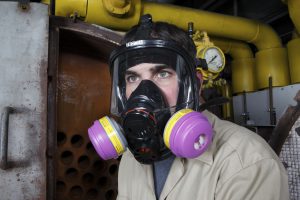Five Things to Know for an Effective Written Respiratory Program
Robin Regan, Contributor

Protection against respiratory hazards is more than a nuisance—exposure to dust, gases and vapors can lead to serious, life-threatening diseases. (photo courtesy Honeywell Industrial Safety)
Whether you work in construction, chemical/pharmaceuticals, healthcare or confined spaces, the risk of exposure to respiratory hazards is inevitable. Just because it’s not always visible, protection against these hazards is more than a nuisance—exposure to dust, gases and vapors can lead to serious, life-threatening diseases.
There is no “one-mask-fits-all” approach to respiratory protection, but sometimes, safety professionals have trouble identifying the best solution for their exact environment. If you’re in the process of reviewing your respiratory program or starting from scratch, here are five things to consider in respiratory PPE selection.
- Written respiratory programs are OSHA-required
Per OSHA standards, if respirators are being used in the workplace, a written program addressing all onsite respiratory hazards is mandatory. This program should be adaptable and fluid to accommodate any changes that may arise. These written programs need to be site-specific and designed to address their unique set of problems and solutions. They must be reviewed at least annually, and if changes are presented from a new contaminant/concentration or a new engineering control.
- Focus on contaminant concentration to select the right respirator
When selecting a respirator, focus on identifying the hazard and the specific contaminant at hand. Respirators are frequently recommended strictly by the work being done or the contaminant present—but it is the concentration that matters most.
For example, most workers exposed to respirable crystalline silica use an N95 disposable respirator. These types of respirators are tested and certified to protect workers up to 500mcg of silica per cubic meter, which is 10 times the permissible exposure limit set by OSHA.
However, if a worker is exposed to an environment with 1,000mcg of silica per cubic meter, they risk developing silicosis or other life-threatening illnesses. Even if an N95 disposable respirator is the solution at hand, in this situation, it would not be enough protection for that concentration. Instead, this worker would be best protected by a full-face respirator with a quantitative fit-test or a powered air-purifying respirator (PAPR).
- Medical evaluations and fit-testing are mandatory before worker usage
Prior to selecting a respirator, workers must complete a medical evaluation to ensure they can safely use it. For most applications, this is done for every new hire. Certain contaminants, such as respirable crystalline silica, may require more frequent medical evaluations. These evaluations can often be done without leaving the workplace by simply completing an online questionnaire. Contaminant-specific medical evaluations are typically done in person, as they may involve chest x-rays, pulmonary function tests and more.
Once a worker is medically cleared to wear a respirator, they must be fit-tested to determine that the respirator fits properly against their face. A correctly worn respirator will be completely sealed around the nose, cheeks and chin to ensure contaminants cannot enter through gaps or breaks in the seal.
A seal check needs to be conducted every time a tight-fitting respirator is put on, and any additional fit-testing is required annually and when the respiratory model or size changes.
Remember, facial hair can influence fit and can compromise the seal of a tight-fitting respirator. This does include disposable respirators, despite dangerous myths that disposable respirators do not require fit-testing. OSHA states that the entire sealing surface must be clear of facial hair and that new growth of facial hair may not exceed one day. However, the same is not true for loose-fitting hoods and helmets. They can be used with facial hair, because they utilize positive pressure and do not seal directly against the face.
- Training and on-going education promotes effective usage
It’s one thing to have the right respirator, but full protection is not achieved when workers aren’t using the equipment correctly. On-going training and continued education on PPE helps workers and safety managers determine why, when and where to use respiratory protection. It also helps to define where there are respirator limitations; inspection needs; and to define a filter/cartridge change-out schedule.
We’ve established that N95 respirators, for instance, need to be fit-tested before use. People not only need to be medically evaluated; they also need to be effectively trained to ensure they understand how to put them on, as well as their protective limitations.
- Ensure proper care and use of respirators—both routine and emergency use
Beyond knowing which respiratory protection to use and how to use it, it’s equally as important to properly care for it. Proper storage, routine cleaning (if required) and adhering to suggested life of masks and cartridges is important. If the respirator gets damaged or soiled, workers need to leave the work area and inform supervisors about the issue immediately.
Conclusion
In 2018, the fourth-most cited OSHA standard was the Respiratory Protection Standard:1910.134. Only by selecting the correct respirator; having an updated written respiratory program; ensuring that medical evaluations and fit-testing is completed; and ensuring the equipment is cared for properly for all workers can we effectively protect workers against respiratory hazards in their work environments. IHW
Robin Regan is Product Sales Manager for Respiratory Protection at Honeywell Industrial Safety. Honeywell offers respiratory protection for any environment, from disposables; air and powered air purifying respirators (APR and PAPR); and a full range of cartridges, filters and other accessories to air-supplied systems and self-contained breathing apparatuses (SCBA). Learn more at https://safety.honeywell.com/en-us/products/by-category/respiratory-protection
Share on Socials!
What Is Respirator Fit Testing (and Why It’s Important for Your Workers)
The Future is Here: Technology in a Pandemic
Breathe Easy: A 10-Step Respiratory Protection Training Plan
Leaders in Industrial Hygiene
Council for Accreditation in Occupational Hearing Conservation (CAOHC)
Subscribe!
Sign up to receive our industry publications for FREE!









